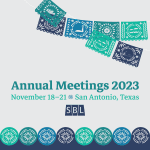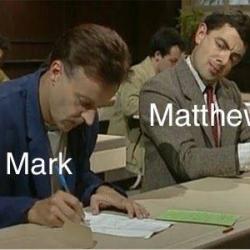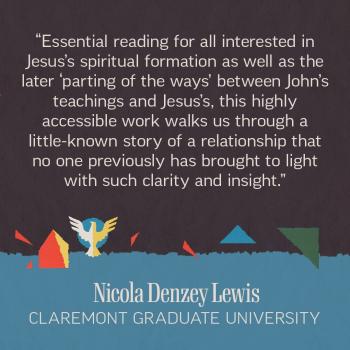I used to be much more fascinated by chiasms than I have been lately. What are chiasms, you ask? Instances in which, in the two-line units characteristic of poetry in Semitic languages such as Hebrew and Aramaic, two keywords or ideas switch places. A classic example from a saying of Jesus:
The sabbath was made for people
not people for the sabbath
“Man” and “sabbath” swap places in the second line. If you draw lines between the matching keywords or concepts it produces the shape of an X (which in Greek is the letter chi, from which the term chiasm derives.
Larger structures that invert halfway through are sometimes also called chiasms, although others prefer to label them as inverted parallelisms to distinguish them from the shorter A B B’ A’ form.
Some people find these everywhere, which has led me to raise the bar when it comes to the evidence I expect to find. But here’s one that I think I caught a glimpse of in the Benedictus (Zechariah’s Song, the poem in Luke 1:68-79), which genuinely seems to reverse the order of key words.
A ὁ θεος τοῦ Ἰσραήλ…ἐπεσκέψατο
B τῷ λαῷ αὐτοῦ…σωτηρίας
C προφητῶν
D ἐχθρῶν…ἐκ χειρος
E πατέρων ἡμῶν
E’ πατέρα ἡμῶν
D’ ἐκ χειρος ἐχθρῶν
C’ προφήτης
B’ σωτηρίας τῷ λαῷ αὐτοῦ
A’ θεοῦ ἡμῶν…ἐπισκέψεται
Francois Rousseau has noticed that in the central section there is an allusion to the meaning of John’s parents’ names as well as his own. See his 1986 article “Les Structures de Benedictus (Luc 1.68–79).”
To perform the mercy [John] promised to our fathers, and to remember [Zechariah] his holy covenant, the oath [Elizabeth] which he swore to our father Abraham.
That leaves a bit off the end, leading me to consider the possibility that it originally belonged with the text known as the Nunc Dimittis or Simeon’s Song. Many of the same keywords occur:
ὅτι εἶδον οἱ ὀφθαλμοί μου το σωτήριόν σου ὃ ἡτοίμασας κατα πρόσωπον πάντων τῶν λαῶν, φῶς εἰς ἀποκάλυψιν ἐθνῶν και δόξαν λαοῦ σου Ἰσραήλ.
Put the pieces together and there’s a natural parallelism in its alternation between Gentiles receiving revelation and us/Israel receiving glory and guidance into the way of peace:
My eyes have seen your salvation,
which you have prepared in the presence of all peoples:
a light for revelation to the gentiles
and for glory to your people Israel
to illuminate those who sit in darkness and in the shadow of death,
to guide our feet into the way of peace
On the other hand, one could perhaps see a chiasm in the Nunc Dimittis on its own:
My eyes have seen your salvation,
which you have prepared in the presence of all peoples:
a light for revelation to the gentiles
and for glory to your people Israel
Perhaps it is one composite piece, with eyes and feet matching at the beginning and end. Is it better to leave the question open, or to propose that Luke might have edited a source with a consistent structure and attempt to pare away that editorial work to reveal the underlying source material? Doing that risks creating something rather than finding it, as is also true in the case of the inverted parallelism I see running through the Benedictus. I think it is genuinely there, but I am all too aware of the potential for scholars to create and impose structure and yet believe we are finding it in the text. To illustrate, here is how one might “detect” (or more likely make) an inverted parallelism in the second half of the Benedictus, which would then cut across and essentially break the keyword arrangement I proposed earlier in this post:
A you will go on before the Lord to prepare the way for him,
B to give his people the knowledge of salvation through the forgiveness of their sins,
C because of the tender mercy of our God,
C’ by which the sprout will visit us from heaven
B’ to shine on those living in darkness and in the shadow of death,
A’ to guide our feet into the path of peace.
You see how easy it is to spot correspondences and posit an arrangement based on much less evidence than in my actual proposal. What do you think? I would really appreciate hearing from readers of my blog about any of this. All of the above is largely relegated to a couple of footnotes in my forthcoming book, but this topic and just about every chapter in my book could be a book-length study in itself. We’ll see whether I devote the rest of my career to writing some of those, expanding on this research, or whether that will be left to others who will come after me.
I provided an update on Facebook a couple of days ago that I’ve now finished a complete draft of the big academic monograph on John the Baptist that I’ve been working on, to be titled John of History, Baptist of Faith. (The biography for a general audience, titled Christmaker, has already been submitted to the publisher). I’ve gone back and forth on whether this book is as groundbreaking as I have sometimes thought, but at the moment I am persuaded that it is. If the conclusions I draw are correct then the book solves the Son of Man problem in the Gospels (I’m giving a paper about that at SNTS in Vienna for those who will be there), explains the origins of Gnosticism, reconstructs a lost infancy narrative about John the Baptist (explaining puzzling things about the Protevangelium of James in the process), shows that Mandaean sources when used critically are relevant to the quest for the historical John the Baptist, and brings the continuity between Jesus of Nazareth and his mentor John into clearer focus. Whether it does any of that persuasively, readers will have to decide. One thing that I’ll promise here is something that I also say in other words in the introduction of the book: If you’ve thought that everything that could usefully be said about John the Baptist had already been rehashed countless times, I hope this will book prove you wrong. The conclusions drawn in the book may or may not be right, but I promise you they will not be boring.













